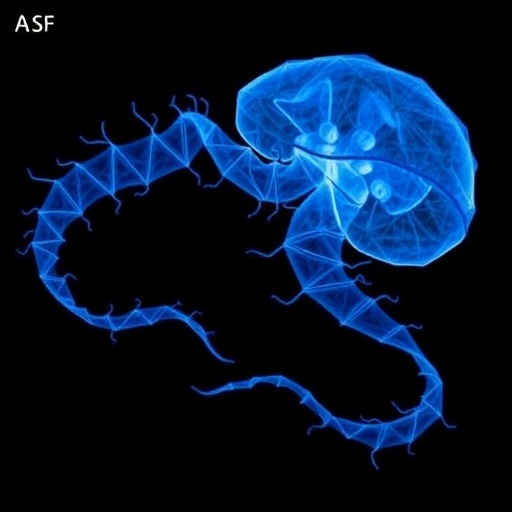In a groundbreaking study, researchers have delved into the intricate world of transfer RNA (tRNA) and its critical functions within the context of phage biology. The focus of this research is centered on the Shigella phage Sf14, a fascinating viral entity that serves as a model to understand how phages can adapt and utilize host machinery for their replication. This phage has gained attention for its ability to manipulate host processes and govern the synthesis of proteins within infected bacterial cells, making it an intriguing subject for computational investigations.
The study conducted by N.D. Ross and S.M. Doore emphasizes the computational approaches that enable scientists to decode the complex interaction between phage-encoded tRNAs and the bacterial host. Phage Sf14, through its specialized tRNA genes, plays a pivotal role in optimizing the translation of viral proteins, which is essential for the phage’s lifecycle. This research not only sheds light on the molecular tactics employed by phages but also opens new avenues for understanding bacterial evolution and pathogenesis.
One of the key revelations from this investigation is the unique evolution of tRNA genes in phage Sf14, which appear to be fine-tuned to match the codon usage bias of its Shigella host. This selection allows for efficient protein synthesis during the viral life cycle. By leveraging advanced bioinformatics tools, the research team was able to analyze the sequence and functional properties of tRNAs encoded by the phage, revealing insights into their contribution to the viral proteome.
The insights gained from this study reveal a fascinating dance between bacteriophages and their bacterial hosts, showcasing the evolutionary arms race that defines their interactions. By encoding tRNAs that can complement and enhance the host’s translational machinery, the phages gain a significant advantage in terms of replication efficiency. This dynamic not only underscores the adaptability of phages but also highlights the evolutionary pressures exerted by bacterial countermeasures aimed at thwarting phage infections.
The implications of this research extend beyond the immediate findings, suggesting potential applications in biotechnology and therapeutic strategies. Understanding how phages exploit host tRNAs could lead to innovative methods of genetic engineering and synthetic biology. Moreover, this knowledge sheds light on the potential of phages to serve as natural antibacterial agents, providing a compelling argument for their use in treating antibiotic-resistant infections.
Moreover, the computational methods employed in this investigation are noteworthy in themselves. The team utilized state-of-the-art algorithms for sequence alignment and functional annotation, which allowed them to identify conserved regions within the phage tRNAs. By coupling these computational analyses with experimental validation, they managed to construct a robust framework for understanding the molecular processes at play.
The role of tRNAs in biological systems extends beyond mere translation; they are integral in regulating various cellular processes. In the context of phage infections, the dynamic interplay between tRNAs and ribosomes can have profound effects on the outcome of the infection. This research posits that phage-encoded tRNAs may not only facilitate the synthesis of viral proteins but may also influence host defenses and metabolic pathways, thereby shaping the course of infection.
The findings presented by Ross and Doore contribute to a larger narrative within the field of virology. As bacteriophages emerge as potential agents for combating bacterial infections, understanding their molecular biology becomes increasingly crucial. The intricate mechanisms governing phage replication, coupled with insights into their interactions with host cellular machinery, could pave the way for new therapeutic interventions.
As we stand at the intersection of computational biology and virology, it becomes evident that the study of phages offers a treasure trove of information. From uncovering the evolutionary strategies employed by these viruses to understanding their potential applications in medicine, research in this field continues to yield transformative insights. The work of Ross and Doore is a testament to the power of interdisciplinary approaches in unraveling the complexities of life on a molecular level.
Ultimately, the implications of this research reach far beyond the realm of basic science. As the world grapples with the challenges posed by antibiotic resistance, the potential of phages as therapeutic agents becomes increasingly compelling. The exploration of tRNA roles in phage biology may not only illuminate our understanding of viral-host interactions but could also inspire the development of novel strategies for harnessing phage therapy in clinical settings.
In conclusion, the computational investigation into the tRNAs encoded by Shigella phage Sf14 marks a significant advancement in our understanding of phage biology. This research not only elucidates the mechanisms underlying viral replication but also sets the stage for future explorations into the therapeutic potentials of bacteriophages. As we continue to unravel the mysteries of these fascinating entities, the future of phage research holds great promise in transforming the landscape of infectious disease treatment.
Subject of Research: The role of tRNAs encoded by Shigella phage Sf14 in viral replication and host interaction.
Article Title: A computational investigation into the role of tRNAs encoded by Shigella phage Sf14.
Article References:
Ross, N.D., Doore, S.M. A computational investigation into the role of tRNAs encoded by Shigella phage Sf14.
BMC Genomics 26, 858 (2025). https://doi.org/10.1186/s12864-025-11998-9
Image Credits: AI Generated
DOI: 10.1186/s12864-025-11998-9
Keywords: tRNA, Shigella phage, computational biology, virology, bacteriophage therapy, antibiotic resistance.
Tags: bacterial evolution and phage interactionscodon usage bias in virusescomputational analysis of tRNA interactionscontributions of tRNA in phage lifecyclemolecular tactics of phagesphage biology and tRNA functionsphage-encoded tRNA genesprotein synthesis optimization in phagesShigella host manipulationShigella phage Sf14transfer RNA in viral replicationviral protein translation mechanisms





